Table of Contents

18. Wastewater Story
All of us use water in our homes and make it dirty. Dirty! Are you surprised? Rich in lather, mixed with oil, black– brown water that goes down the drains from sinks, showers, toilets, laundries is dirty. It is called wastewater. This used water should not be wasted. We must clean it up by removing pollutants. Have you ever thought where the wastewater goes and what happens to it?
18.1 Water, Our Lifeline
Clean water is a basic need of human being. Let us make a mindmap of the many uses of clean water.
Activity 18.1
(We have given one example of the use of clean water. You can add many more.)
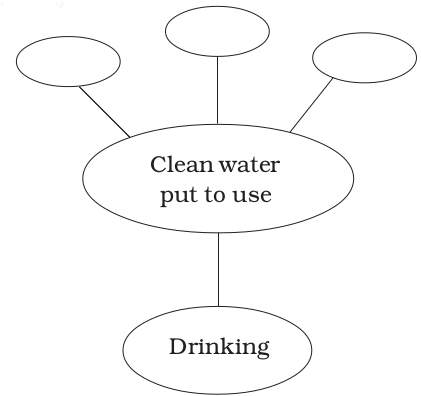
Clean water that is fit for use is unfortunately not available to all. It has been reported that more than one billion of people have no access to safe drinking water. This accounts for a large number of water-related diseases and even deaths. People even children walk for several kilometres to collect clean water, as you read in Chapter 16. Is it not a serious matter for human dignity?
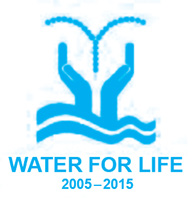
You have studied in Chapter 16 about the increasing scarcity of fresh- water due to population growth, pollution, industrial development, mismanagement and other factors. Realising the urgency of the situation on the World Water Day, on 22 March 2005, the General Assembly of the United Nations proclaimed the period 2005–2015 as the International Decade for action on “Water for life”. All efforts made during this decade aim to reduce by half the number of people who do not have access to safe drinking water.
There has been perceptible progress in the direction of the aim but still there is a lot to achieve.
Cleaning of water is a process of removing pollutants before it enters a water body or is reused. This process of wastewater treatment is commonly known as “Sewage Treatment”. It takes place in several stages.
18.2 What is Sewage?
Sewage is wastewater released by homes, industries, hospitals, offices and other users. It also includes rainwater that has run down the street during a storm or heavy rain. The water that washes off roads and rooftops carries harmful substances with it. Sewage is a liquid waste. Most of it is water, which has dissolved and suspended impurities.
Activity 18.2
Locate an open drain near your home, school or on the roadside and inspect water flowing through it.
Record colour, odour and any other observation. Discuss with your friends and your teacher and fill up the following Table 18.1.
We know that sewage is a complex mixture containing suspended solids, organic and inorganic impurities, nutrients, saprophytes and disease causing bacteria and other microbes. These include the following.
Organic impurities – Human faeces, animal waste, oil, urea (urine), pesticides, herbicides, fruit and vegetable waste, etc.
Inorganic impurities – Nitrates, Phosphates, metals.
Nutrients – Phosphorus and Nitrogen.
Bacteria – Such as vibrio cholera which causes cholera and salmonella paratyphi which causes typhoid.
Other microbes – Such as protozones which cause dysentery.
18.3 Water Freshens Up — An Eventful Journey
In a home or a public building generally one set of pipes brings clean water and another set of pipes takes away wastewater. Imagine that we could see through the ground. We would see a network of big and small pipes, called sewers, forming the sewerage. It is like a transport system that carries sewage from the point of being produced to the point of disposal, i.e. treatment plant.

Manholes are located at every 50 m to 60 m in the sewerage, at the junction of two or more sewers and at points where there is a change in direction.
Activity 18.3
- Make a line diagram of the sewage route.
- Walk down the street or survey the campus to find the number of manholes.
- If possible, observe open drain and record which living organisms are found in and around it.
- In case you do not have a sewerage system in your locality, find out how sewage is being disposed off.
Treatment of polluted water
Perform the following activity. It will help you understand the processes that take place at the wastewater treatment plant.
Activity 18.4
Divide yourself into groups to perform the activity. Record observations at each stage:
- Fill a large glass jar 3/4 full of water. Add some dirty organic matter such as grass pieces or orange peels, a small amount of detergent, and a few drops of an ink or any colour.
- Cap the jar, shake it well and let the mixture stand in the sun for two days.
- After two days, shake the mixture and pour a small sample into test tube. Label this test tube “Before treatment; Sample 1”. How does it smell?
- Use an aerator from an aquarium to bubble air through the sample in the glass jar. Allow several hours for aeration; leave the aerator attached overnight. If you do not have an aerator, use a mechanical stirrer or a mixer. You may have to stir it several times.
- The next day when aeration is complete, pour another sample into a second test tube. Label it as “After aeration; Sample 2”.
- Fold a piece of filter paper to form a cone. Wet the paper with tap water and then insert the cone in a funnel. Mount the funnel on a support (as you have learnt in Class VI).
- Place layers of sand, fine gravel and finally medium gravel in the funnel (Fig. 18.2). (An actual filtration plant does not use filter paper, but the sand filter is several metres deep).
- Pour the remaining aerated liquid through the filter into the beakers. Do not allow the liquid to spill over the filter. If the filtered liquid is not clear, filter it a few times till you get clear water.
- Pour a sample of the filtered water into a third test tube labelled “Filtered; Sample 3”.
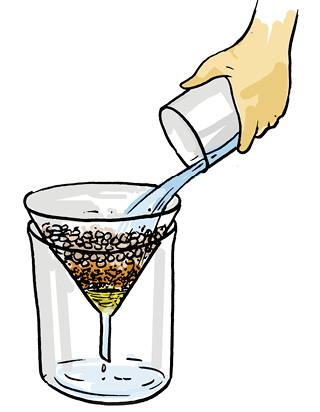 \
\- Pour another sample of the filtered water into a fourth test tube. Add a small piece of a chlorine tablet. Mix well until the water is clear. Label the test tube “Chlorinated; Sample 4”.
- Observe carefully the samples in all the test tubes. Do not taste! Just smell them!
Now answer the following questions:
(a) What changes did you observe in the appearance of the liquid after aeration?
(b) Did aeration change the odour?
(c) What was removed by the sand filter?
(d) Did chlorine remove the colour?
(e) Did chlorine have an odour? Was it worse than that of the wastewater?
18.4 Wastewater Treatment Plant (WWTP)
Treatment of wastewater involves physical, chemical, and biological processes, which remove physical, chemical and biological matter that contaminates the wastewater.
1. Wastewater is passed through bar screens. Large objects like rags, sticks, cans, plastic packets, napkins are removed (Fig. 18.3).
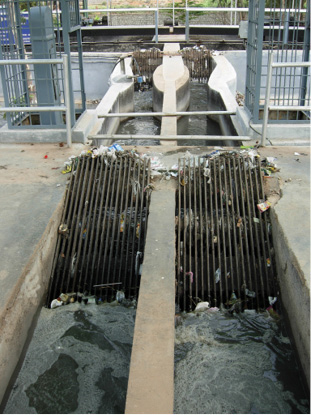
Fig. 18.3 Bar screen
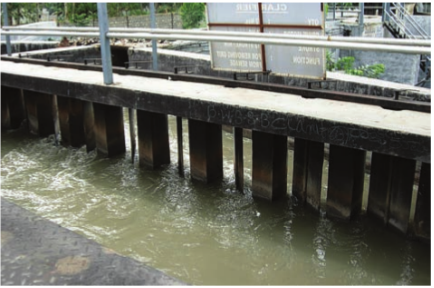
3. The water is then allowed to settle in a large tank which is sloped towards the middle. Solids like faeces settle at the bottom and are removed with a scraper. This is the sludge. A skimmer removes the floatable solids like oil and grease. Water so cleared is called clarified water (Fig. 18.5).
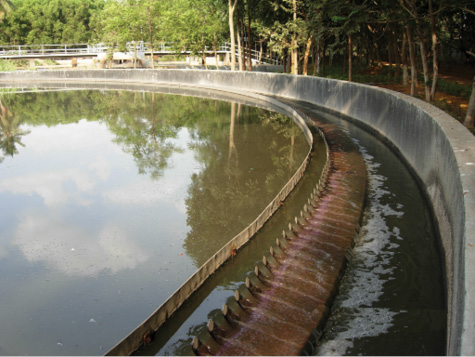
Fig. 18.5 Water clarifer
The sludge is transferred to a separate tank where it is decomposed by the anaerobic bacteria. The biogas produced in the process can be used as fuel or can be used to produce electricity.
4. Air is pumped into the clarified water to help aerobic bacteria to grow. Bacteria consume human waste, food waste, soaps and other unwanted matter still remaining in clarified water (Fig. 18.6).

Fig. 18.6 Aerator
After several hours, the suspended microbes settle at the bottom of the tank as activated sludge. The water is then removed from the top.
The activated sludge is about 97% water. The water is removed by sand drying beds or machines. Dried sludge is used as manure, returning organic matter and nutrients to the soil.
The treated water has a very low level of organic material and suspended matter. It is discharged into a sea, a river or into the ground. Nature cleans it up further. Sometimes it may be necessary to disinfect water with chemicals like chlorine and ozone before releasing it into the distribution system.
Become an active citizen

| Did you know ? |
It has been suggested that we should plant eucalyptus trees all along sewage ponds. These trees absorb all surplus wastewater rapidly and release pure water vapour into the atmosphere. |

18.5 Better Housekeeping Practices
- Cooking oil and fats should not be thrown down the drain. They can harden and block the pipes. In an open drain the fats clog the soil pores reducing its effectiveness in filtering water. Throw oil and fats in the dustbin.
- Chemicals like paints, solvents, insecticides, motor oil, medicines may kill microbes that help purify water. So do not throw them down the drain.
- Used tealeaves, solid food remains, soft toys, cotton, sanitary towels, etc. should also be thrown in the dustbin (Fig. 18.7). These wastes choke the drains. They do not allow free flow of oxygen. This hampers the degradation process.
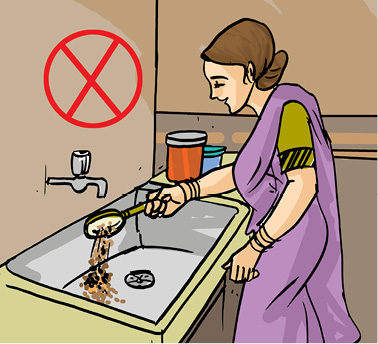
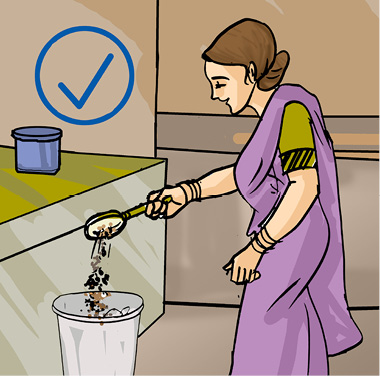
In the year 2016, the Government of India has initiated a new mission known as “Swachh Bharat” under which a lot of drives such as proper sewage disposal and providing toilets for everyone have been started.
In the year 2016, the Government of India has initiated a new mission known as “Swachh Bharat” under which a lot of drives such as proper sewage disposal and providing toilets for everyone have been started. |
Vermi-processing toilet
A design of a toilet in which humans excreta is treated by earthworms has been tested in India. It has been found to be a novel, low water-use toilet for safe processing of human waste. The operation of the toilet is very simple and hygienic. The human excreta is completely converted to vermi cakes — a resource much needed for soil.
| Vermi-processing toilet |
A design of a toilet in which humans excreta is treated by earthworms has been tested in India. It has been found to be a novel, low water-use toilet for safe processing of human waste. The operation of the toilet is very simple and hygienic. The human excreta is completely converted to vermi cakes — a resource much needed for soil. |
18.6 Sanitation and Disease
Poor sanitation and contaminated drinking water is the cause of a large number of diseases.
Let us look at our own country. A vast number of our people are still without sewerage facilities. Where do they relieve themselves?
A very large fraction of our people defecates in the open, on dry riverbeds, on railway tracks, near fields and many a time directly in water. Untreated human excreta is a health hazard. It may cause water pollution and soil pollution. Both the surface water and groundwater get polluted. Groundwater is a source of water for wells, tubewells, springs and many rivers as you learnt in Chapter 16. Thus, it becomes the most common route for water borne diseases. They include cholera, typhoid, polio, meningitis, hepatitis and dysentery.
18.7 Alternative Arrangement for Sewage Disposal
Some organisations offer hygienic on-site human waste disposal technology. These toilets do not require scavenging. Excreta from the toilet seats flow through covered drains into a biogas plant. The biogas produced is used as a source of energy.
18.8 Sanitation at Public Places
In our country fairs are organised periodically. A large number of people participate in them. In the same way railway stations, bus depots, airports, hospitals are very busy places. Thousands of people visit them daily. Large amount of waste is generated here. It must be disposed of properly otherwise epidemics could break out.
The government has laid down certain standards of sanitation but, unfortunately, they are not strictly enforced.
However, all of us can contribute in maintaining sanitation at public places. We should not scatter litter anywhere. If there is no dustbin in sight, we should carry the litter home and throw it in the dustbin.
Conclusion
We all have a role to play in keeping our environment clean and healthy. You must realise your responsibility in maintaining the water sources in a healthy state. Adopting good sanitation practices should be our way of life. As an agent of change your individual initiative will make a great difference. Influence others with your energy, ideas and optimism. A lot can be done if people work together. There is great power in collective action.
Mahatma Gandhi said:
“No one need to wait for anyone else to adopt a humane and enlightened course of action."
Mahatma Gandhi said: “No one need to wait for anyone else to adopt a humane and enlightened course of action." |
| Keywords | ||
| Aeration | Contaminant | Sewerage |
| Aerobic bacteria | Sanitation | Sludge |
| Anaerobic bacteria | Sewage | Wastewater |
| Biogas | Sewer |
| What you have learnt |
|
Exercises
1. Fill in the blanks:
(a) Cleaning of water is a process of removing ____________.
(b) Wastewater released by houses is called ____________.
(c) Dried ____________ is used as manure.
(d) Drains get blocked by ____________ and ____________.
2. What is sewage? Explain why it is harmful to discharge untreated sewage into rivers or seas.
3. Why should oils and fats be not released in the drain? Explain.
4. Describe the steps involved in getting clarified water from wastewater.
5. What is sludge? Explain how it is treated.
6. Untreated human excreta is a health hazard. Explain.
7. Name two chemicals used to disinfect water.
8. Explain the function of bar screens in a wastewater treatment plant.
9. Explain the relationship between sanitation and disease.
10. Outline your role as an active citizen in relation to sanitation.
1 1. Here is a crossword puzzle: Good luck!
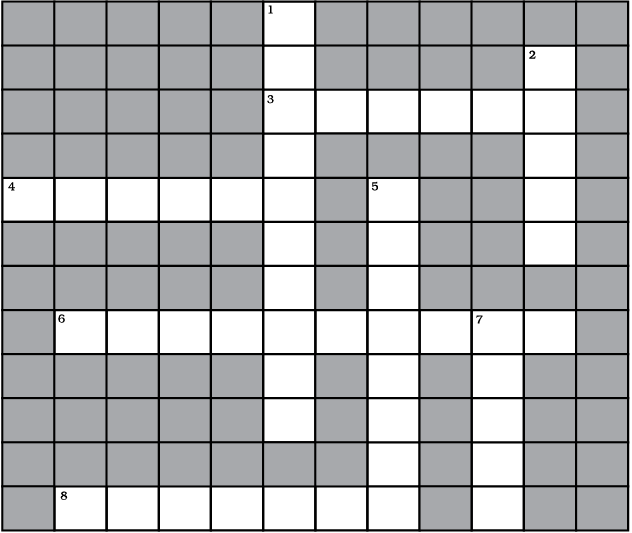
Across
3. Liquid waste products
4. Solid waste extracted in sewage treatment
6. A word related to hygiene
8. Waste matter discharged from human body
Down
1. Used water
2. A pipe carrying sewage
5. Micro-organisms which causes cholera
7. A chemical to disinfect water
12. Study the following statements about ozone:
(a) It is essential for breathing of living organisms.
(b) It is used to disinfect water.
(c) It absorbs ultraviolet rays.
(d) Its proportion in air is about 3%.
Which of these statements are correct?
(ii) (b) and (c)
(iii) (a) and (d)
(iv) All four
Extended learning — Activities and Projects
1. Construct a crossword puzzle of your own using the keywords.
2. Then and now: Talk to your grand parents and other elderly people in the neighbourhood. Find out the sewage disposal systems available to them. You can also write letters to people living in far off places to get more information. Prepare a brief report on the information you
collected.
3. Visit a sewage treatment plant.
It could be as exciting and enriching as a visit to a zoo, a museum, or a park. To guide your observation here are a few suggestions.
Record in your notepad:
Place ___________ Date ___________ Time ___________
Name of the official at the plant __________ Guide/Teacher ___________
(a) The location of the sewage plant.
(b) Treatment capacity.
(c) The purpose of screening as the initial process.
(d) How is air bubbled through the aeration tank?
(e) How safe is the water at the end of the treatment? How is it tested?
(f) Where is the water discharged after treatment?
(g) What happens to the plant during heavy rains?
(h) Is biogas consumed within the plant or sold to other consumers?
(i) What happens to the treated sludge?
(j) Is there any special effort to protect nearby houses from the plant?
(k) Other observations.
For more information, consult:
Millennium Development Goals:
“Water for Life” International Decade for Action:
http://www.un.org/waterforlifedecade/
http://www.cep.unep.org/pubs/Techreports/tr43en/Household%
20systems.htm
“By providing clean water and sanitation to the poorest people on the planet, we can reduce poverty and suffering and ensure education for all children.”—UNICEF |
| An early engineering feat: indus valley civilisation |
One of the ancient civilisations, Harappa and Mohenjodaro had perhaps the world’s first urban sanitation system. Within the city individual houses, or groups of houses, obtained water from wells. There was a separate room for bathing, and wastewater was directed to the covered drains which lined the major streets. The oldest toilet made of bricks is about 4500 years old. |
